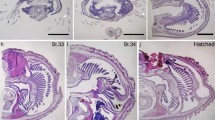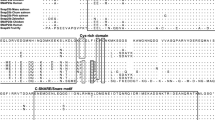Abstract
Expression of pamlin, a heterotrimeric primary mesenchyme cell (PMC) adhesion glycoprotein, and its role during early embryogenesis were examined using immunochemistry and microinjection of pamlin to tunicamycin-treated embryos of the sea urchin, Hemicentrotus pulcherrimus. Pamlin faintly detected in egg cortex before fertilization was strongly expressed in the hyaline layer after fertilization. The embryonic apical surface retained pamlin throughout early embryogenesis, whereas pamlin on the basal surface showed a dynamic change of spatio-temporal distribution from morula to gastrula stage. Pamlin distributed on the entire basal surface of the ectoderm before onset of invagination gradually disappeared from the presumptive archenteron during gastrulation, and then was restricted to the apical tuft region and the PMC sessile sites in early gastrulae. Tunicamycin, an inhibitor of N-glycosydically linked carbohydrate formation, inhibited PMC migration and gastrulation. Tunicamycin also inhibited the assembly of mannose moieties of 180 and 52 kDa subunits of pamlin. Pamlin microinjection to the tunicamycin-treated embryos rescued them from this morphogenetic disturbance. PMCs did not bind to pamlin isolated from the tunicamycin-treated embryos. The present study indicated that pamlin plays an essential role in PMC migration, its termination and gastrulation, and the presence of N-glycosydically linked carbohydrate moieties that contain mannose are necessary to preserve the biological function of pamlin.
Similar content being viewed by others
References
Amemiya S (1989) Development of the basal lamina and its role in migration and pattern formation of primary mesenchyme cells in sea urchin embryos. Dev Growth Differ 31:131–145
Bisgrove BW, Andrews ME, Raff RA (1991) Fibropellins, products of an EGF-containing gene, from a unique extracellular matrix structure that surround the sea urchin embryo. Dev Biol 146:89–99
Bronner-Fraser M (1986) Guidance of neural crest migration: Latex beads as probes of surface-substratum interactions. In: Browder LW (ed) Developmental biology: a comprehensive synthesis, vol 3. The cell surface in development and cancer. Plenum Press, New York, pp 301–338
Giudice G (1973) Developmental biology of the sea urchin embryo. Academic Press, New York
Hames BD (1990) One-dimensional polyacrylamide gel electrophoresis. In: Hames BD, Rickwood D (eds) Gel electrophoresis of proteins; a practical approach, 2nd edn. IRL Press, New York, pp 1–147
Hardin J (1988) The role of secondary mesenchyme cells during sea urchin gastrulation studied by laser ablation. Development 103:317–324
Hardin J, McClay DR (1990) Target recognition by the archenteron during sea urchin gastrulation. Dev Biol 142:86–102
Heifetz A, Lennertz WJ (1979) Biosynthesis of N-glycosydically linked glycoproteins during gastrulation of sea urchin embryos. J Biol Chem 254:6110–6127
Humphries MJ, Mould AP, Yamada KM (1991) Matrix in cell migration. In: McDonald JA, Meacham RP (eds) Receptors for extracellular matrix. Academic Press, San Diego, pp 195–253
Hynes RO (1990) Fibronectins. Springer, Berlin Heidelberg New York
Hynes RO, Lander AD (1992) Contact and adhesion specificities in the association, migration, and targeting of cells and axons. Cell 68:303–322
Karp GC, Solursh M (1985) Dynamic activity of the filopodia of sea urchin embryonic cells and their role in exploratory behavior of the primary mesenchyme in vitro. Dev Biol 112:276–283
Katow H (1986) Behavior of sea urchin primary mesenchyme cells in artificial extracellular matrices. Exp Cell Res 162:401–410
Katow H (1987) Inhibition of cell surface binding of fibronectin and fibronectin-promoted cell migration by synthetic peptides in sea urchin primary mesenchyme cells in vitro. Dev Growth Differ 29:579–589
Katow H (1990) A new technique for introducing anti-fibronectin antibodies and fibronectin-related synthetic peptides into the blastulae of the sea urchin, Clypeaster japonicus. Dev Growth Differ 32:33–39
Katow H (1995) Pamlin, a primary mesenchyme cell adhesion protein, in the basal lamina of the sea urchin embryo. Exp Cell Res 218:469–478
Katow H, Hayashi M (1985) Role of fibronectin in primary mesenchyme cell migration in the sea urchin. J Cell Biol 101: 1487–1491
Katow H, Nakajima Y (1992) Behavior and ultrastructure of primary mesenchyme cells at sessile site during termination of cell migration in early gastrulae. Dev Growth Differ 34:107–114
Katow H, Solursh M (1979) Ultrastructure of blastocoel material in blastulae and gastrulae of the sea urchin, Lytechinus pictus. J Exp Zool 210:561–567
Katow H, Solursh M (1982) In situ distribution of concanavalin A-binding sites in mesenchyme blastulae and early gastrulae of the sea urchin, Lytechinus pictus. Exp Cell Res 139:171–180
Katow H, Yazawa S, Sofuku S (1990) A fibronectin-related synthetic peptide, Pro-Ala-Ser-Ser, inhibits fibronectin binding to the cell surface, fibronectin-promoted cell migration in vitro, and cell migration in vivo. Exp Cell Res 190:17–24
Katow H, Yazawa S, Sofuku S (1991) Inhibition of cell surface binding of fibronectin and fibronectin-promoted cell migration in vitro by a fibronectin-related synthetic peptide, Pro-Ala-Ser-Ser, in the sea urchin, Pseudocentrotus depressus. St Paul's Rev Sci 31:1–10
Laemmli UK (1970) Cleavage of structural proteins during the assembly of the bacteriophage T4. Nature 227:680–685
Lane MC, Solursh M (1988) Dependence of sea urchin primary mesenchyme cell migration on xyloside- and sulfate-sensitive cell surface-associated compound. Dev Biol 127:78–87
Lane MC, Solursh M (1991) Primary mesenchyme cell migration requires a chondroitin sulfate/dermatan sulfate proteoglycan. Dev Biol 143:389–397
Lee HC, Epel D (1983) Changes in intercellular acidic compartments in sea urchin eggs after activation. Dev Biol 98:446–454
McCarthy RA, Beck K, Burger MM (1987) Laminin is structurally conserved in the sea urchin basal lamina. EMBO J 6:1587–1593
McClay DR (1993) Assembly of the extracellular matrix following fertilization of the sea urchin embryo. J Reprod Dev Suppl 39:85–86
Merril CR (1990) Gel stain technique. In: Deutcher MP (ed) Methods in enzymology, vol 182. Guide to protein purification. Academic Press, San Diego, pp 477–488
Nakajima Y, Katow H (1991) Initial characterization of primary mesenchyme cell homing site in sea urchin blastulae. In: Yanagisawa K, Yasumasu I, Oguro C, Suzuki N, Motokawa T (eds) Biology of echinodermata. Balkema, Rotterdam, pp 461–466
Newgreen DF (1990) Control of the directional migration of mesenchyme cells and neurites. Semin Dev Biol 1:301–311
Okazaki K, Fukushi T, Dan K (1962) Cyto-embryological studies of sea urchins. IV. Correlation between the shape of the ectodermal cells and the arrangement of the primary mesenchyme cells in sea urchin larvae. Acta Embryol Morphol Exp 5:17–31
Shimizu-Nishikawa K, Katow H, Matsuda R (1990) Micromere differentiation in the sea urchin embryo: immunochemical characterization of primary mesenchyme cell-specific antigen and its biological roles. Dev Growth Differ 32:629–636
Soltysik-Espanola M, Klinzing DC, Pfarr K, Burk RD, Ernst SG (1994) Endo 16, a large multidomain protein found on the surface and ECM of endodermal cells during sea urchin gastrulation, binds calcium. Dev Biol 165:73–85
Solursh M (1986) Migration of sea urchin primary mesenchyme cells. In: Browder LW (ed) Developmental biology. A comprehensive synthesis. Plenum Press, New York, pp 391–432
Solursh M, Lane MC (1988) Extracellular matrix triggers a directed cell migratory response in sea urchin primary mesenchyme cells. Dev Biol 130:397–401
Struck DK, Lennarz WJ (1981) The fuction of saccharide-lipids in synthesis of glycoproteins. In: Lennarz WJ (ed) The biochemistry of glycoproteins and proteoglycans. Plenum Press, New York, pp 35–83
Towbin H, Staehelin T, Gordon J (1979) Electrophoretic transfer of proteins from acrylamide gels to nitrocellulose sheets: procedure and applications. Proc Natl Acad Sci USA 76:4350–4354
Welply JK, Lau JT, Lennarz WJ (1985) Developmental regulation of glycosyltransferases involved in synthesis of N-linked glycoproteins in sea urchin embryos. Dev Biol 107:252–258
Wessel GM, McClay DR (1987) Gastrulation in the sea urchin embryo requires the deposition of crosslinked collagen within the extracellular matrix. Dev Biol 121:149–165
Yamamoto Y, Katow H, Sofuku S (1995) Synthesis of RGDS-PASS-containing cysteine peptides and isolation of RGD-recognizing receptor in sand dollar embryo by the peptide-affinity chromatography. Chem Lett 1995:483–484
Author information
Authors and Affiliations
Rights and permissions
About this article
Cite this article
Katow, H., Komazaki, S. Spatio-temporal expression of pamlin during early embryogenesis in sea urchin and importance of N-linked glycosylation for the glycoprotein function. Roux's Arch Dev Biol 205, 371–381 (1996). https://doi.org/10.1007/BF00377217
Received:
Accepted:
Issue Date:
DOI: https://doi.org/10.1007/BF00377217




